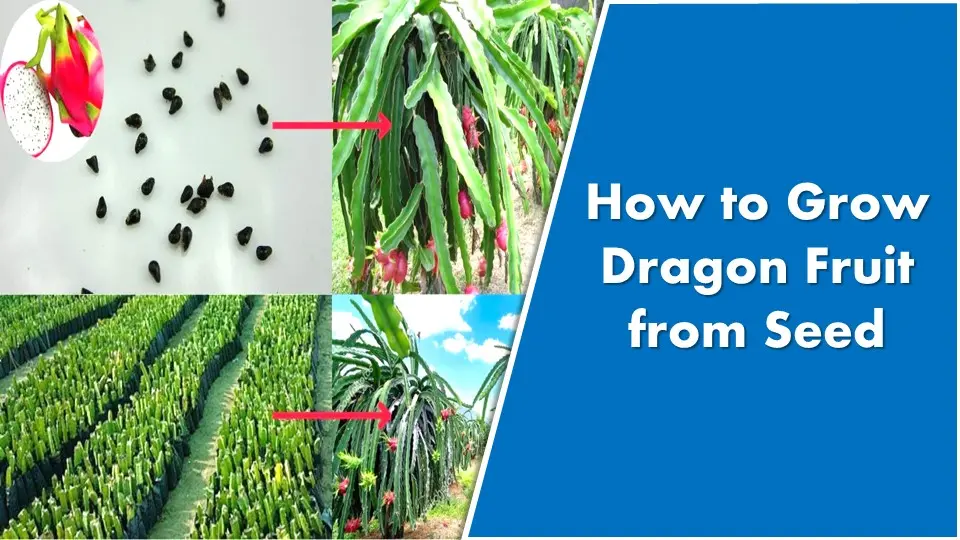How to Grow Dragon Fruit from Seed Effectively : Best Method
Hello Growers! Are you interested in the cultivation of dragon fruit from the seed? If yes, this article is for you: “From Seed to Harvest: A Comprehensive Article on Dragon Fruit Cultivation.” “How to grow dragon fruit from seed”. Let us delve into the article to address the nutritional values, health benefits, and growing demand for dragon fruit in the market. Additionally, this article provides a comprehensive overview of the importance of dragon fruit and the crucial steps to be followed in cultivating dragon fruit from seed.
What is Dragon Fruit?
The dragon fruit is a huge climbing cactus plant that bears red or yellow fruits from succulent branches. The dragon fruit plant produces the fruit known as dragon fruit, pitaya, pitahaya, or strawberry pear. Dragon fruit is rich, juicy, and sweet; it can be eaten raw, cut into salads, or blended to make smoothies or ice cream. Dragon fruit trees also produce some of the world’s largest blooms, known as “night-blooming cereus,” which appear for only one night as magnificent white flowers.
Dragon fruit, despite being a cactus, performs poorly in extreme temperatures and cannot endure bright light. Dragon fruit requires a warm atmosphere; thus, it flourishes well in semi-arid areas. For optimal growth, temperatures between 18-25°C with high relative humidity are recommended. In this, we are going to learn how to grow dragon fruit from seed.
Importance of Dragon Fruit:
Dragon fruit is a lucrative plant with amazing health benefits. It is still a new introduction to India, and much experimentation is underway at institutes and the farmer’s field level. While dragon fruit was a famous fruit in countries like Sri Lanka and Thailand, it recently gained prominence in India. Indians have now started consuming these fruits for a wide range of health benefits. Hence, consumer demand is also growing in India.
People are consuming it as a fruit, making jams, and preparing ice cream with this fruit. The fruit is not excessively sweet; it has wide health benefits too. It is in great demand in the food industry because of its hydration properties, Dragon fruit is now even used in cosmetics and skincare, especially for face masks and face packs. The fruit has a great market value, where the cost of one piece of dragon fruit is around 70–80 rupees.
Nutritional Benefits of Dragon Fruit:
| Nutrient | Amount per 100g |
| Water | 87g |
| Protein | 1.1g |
| Fat | 0.4g |
| Carbohydrates | 11g |
| Fiber | 3g |
| Vitamin B1 | 0.04g |
| Vitamin B2 | 0.05g |
| Vitamin B3 | 0.16g |
| Vitamin C | 20.5g |
Types of Dragon Fruit:
There are three varieties of dragon fruits that home gardeners grow:
Hyalocerus undatus:
This dragon fruit is native to Central and South America and has gained popularity worldwide for its unique appearance, refreshing taste, and potential health benefits.
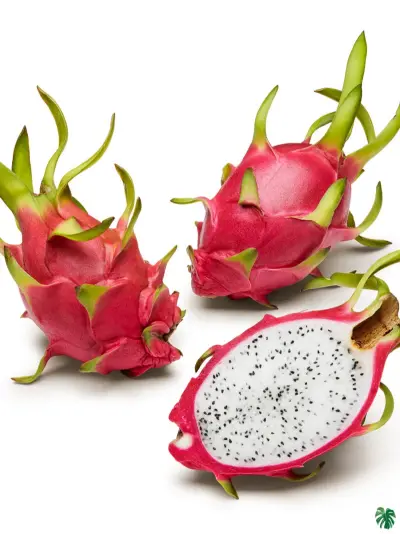
Hyalocereus megalanthus:
This, also called pitaya amarilla or yellow pitaya, has yellow-skinned fruit with white flesh.
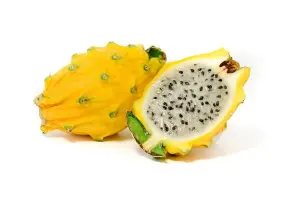
Hyalocereus costraricensis:
This, also called pitaya roja or red-fleshed pitaya, is a red-skinned fruit with red flesh.
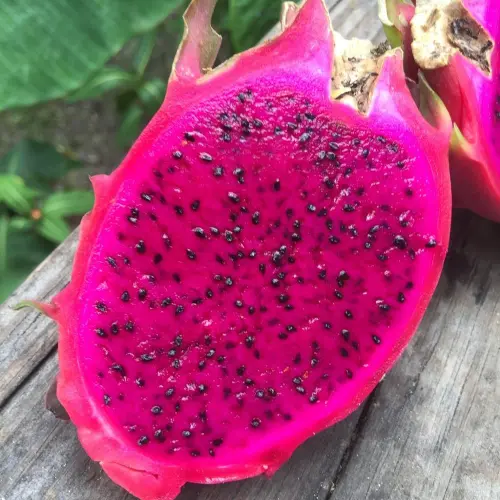
Hyalocereus costraricensis:
Red dragon fruit, also known as Pitaya Rouge or Pink Pitaya, is a tropical fruit with pear or oval-shaped skin that’s bright pink to deep red with green scales.
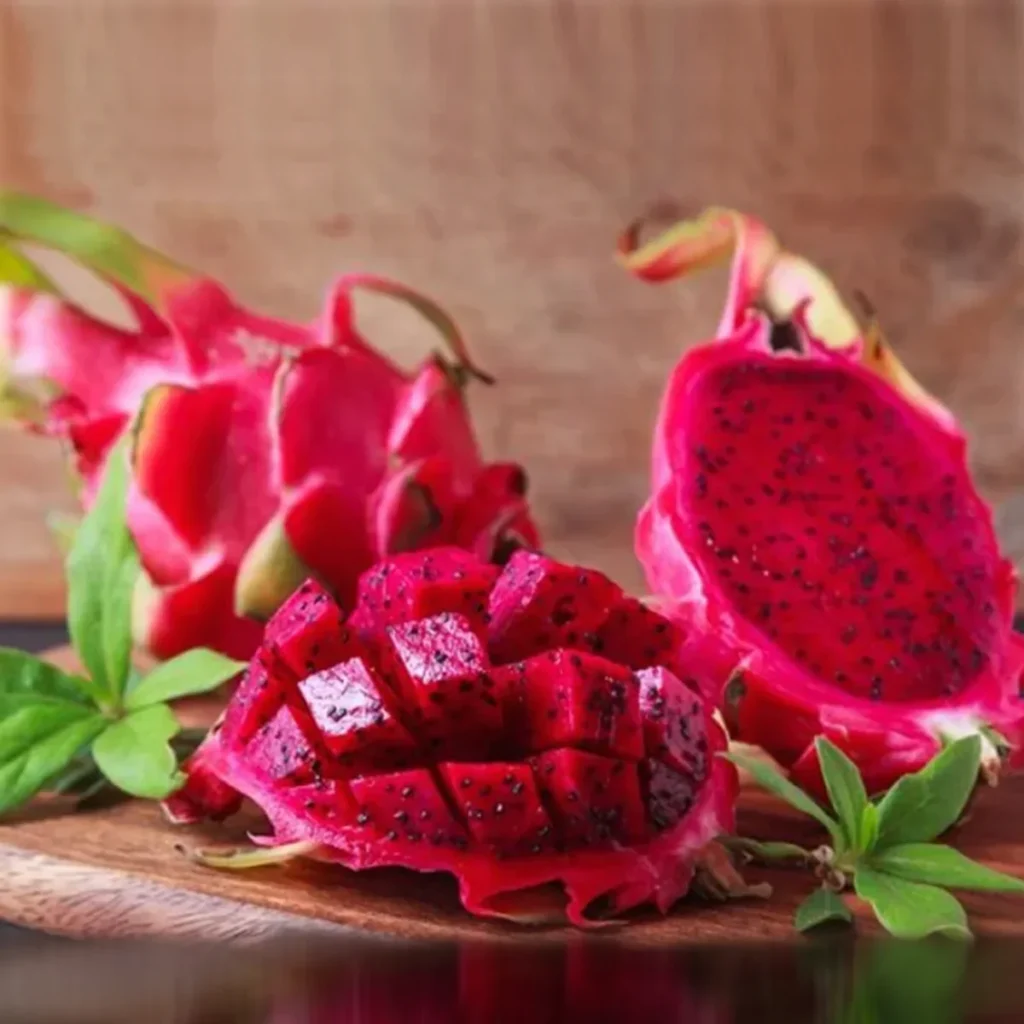
Steps How to Grow Dragon Fruit from Seed
Seed Selection:
Selecting high-quality seeds is the most critical first step in the successful growth of dragon fruit. If you decide to buy seeds, be sure to get them from ripe, healthy fruits; ideally, you may get them from a nursery or authorized provider. Seek seeds from recently picked vegetables since they have a better germination rate than seeds from older ones.
Seed Preparation:
The germination process of dragon fruit seeds is distinct. It will take many days to remove the seeds from the fruit pulp and dry them. Once the seeds have dried, plant them in a shallow tray filled with a uniform soil mixture, lightly wet, and keep them in a warm location. Soaking the seeds for 24 to 48 hours in warm water is an additional option. A seed’s covering is weakened when it is soaked in water, hastening the process of germination.
For optimal dragon fruit growth, choose a bright spot in your yard that receives at least six hours of direct sunlight each day. Ensure that the potting mix is well-drained, slightly acidic or neutral in pH (dragon fruits are sensitive to waterlogged conditions), and rich in organic matter. To avoid waterlogging and potential plant damage, choose a pot with drainage holes. Choose a pot size large enough to allow your dragon fruit plant to grow naturally.
Soil bed preparation:
Select a sunny area in your yard that gets at least six hours of direct sunshine every day for the best dragon fruit development. Because dragon fruits are sensitive to moisture, make sure the potting mix is well-drained, neutral or slightly acidic in pH, and high in organic matter. Pick a pot with drainage holes to prevent waterlogging and possible plant harm. Select a container that is big enough to let your dragon fruit plant develop organically.
Planting the Dragon Fruit Seeds:
Place the ready-to-plant seeds ¼ to ½ inch deep in the potting mixture. As much as one to two inches should separate the seeds to promote optimal germination and development. Shortly after planting, softly wet the soil to help the water settle around the seeds.
Irrigating the beds and pots for Dragon Fruit :
Compared to other crops or fruits, dragon fruit takes relatively little water because it is a cactus. Without water, dragon fruit plants may endure for several months. Dragon fruit grows best when grown with drip irrigation. During fruit growth, the Drip Irrigation technique is employed to keep soil moisture levels consistent. It is not advised to irrigate during floods, as this wastes water and promotes the growth of weeds. Give the plants regular irrigation and use a slow-release fertilizer.
Germination and growth of seedlings:
Typically, dragon fruit seeds germinate in 1-2 weeks under normal and ideal conditions. We have to place the seed pot in bright and warm conditions with indirect sunlight, and also we have to ensure that the soil is wet during the period of germination
Thinning:
As dragon fruit seedlings continue to grow, thinning is the most important step to permit the remaining fruits to grow more rapidly, prevent the development of such large crops, and enable them to give each new plant room. If you’re growing them indoors, transplant them to larger pots, which enhances further growth and development. A mature dragon fruit will eventually need at least a twenty-gallon pot for optimal growth.
Seedling transplantation:
When seedlings develop a few genuine sets of leaves, they are transplanted—that is, placed in bigger pots. This is crucial because the healthy growth and development of the seedlings depend on enough hydration. Pick a spot where the climbing vines will have access to plenty of sunshine and support structures. Take caution when handling the seedlings to prevent breaking their fragile roots.
Care and Maintenance for Dragon Fruit:
Dragon fruit plants require regular care and maintenance to thrive and yield nutritious fruits. Some of the actions required to care for and sustain dragon fruit plants.
Water Management:
As dragon fruit belongs to the cactacea family, it consumes less water than any other plant. A stable supply of water is essential, especially during flowering and fruiting periods. It is generally recommended that drip irrigation is the most effective type of irrigation for dragon fruit farming, as it keeps the soil moist during fruit development. It is generally recommended to maintain a twice-weekly irrigation frequency during dry seasons. Excess moisture and waterlogging must be avoided to prevent pest infestations because the flowering and fruiting seasons overlap with the rainy season.
Fertilizer Management:
Judicious application of manures and fertilizers to grow, develop, and increase crop output. Adding slow-release fertilizer to the soil every 2-3 months is essential to providing critical nutrients to the plants. Enough nutrients should be provided through basal and fertigation using the drip method.
Pruning and Training:
Pruning is essential in dragon fruit crop cultivation to keep the plant’s shape and size, as they develop quickly. Dragon fruit requires trimming to increase plant vigor and produce more and higher-quality fruits, as well as to facilitate plant handling for optimal size. Cut any superfluous, inconvenient, unhealthy, or dry branches.
Flowering and fruiting:
Dragon fruit blossoms are off-white and appear at night. The perfume of the blossoms attracts a range of pollinators, including honeybees (Apis cerema), small honeybees (Apis florae), and rock bees (Apis dorsata), all of which successfully pollinate dragon fruit in the early morning. Flower thinning should be done such that no more than 80 blossoms remain on each pole at any given time.
Fruits that are closely spaced on the same branch should be removed. Fruits will appear 30–35 days after blooming. Dragon fruit is unpredictable, and flowering and fruiting used to occur simultaneously. Cotton bags should be used to cover fruits when their color changes from green to red to control the damage caused by bird bites and pests. The same bags can be used multiple times.
Management of pests and diseases:
Dragon fruit plants are very resistant to various pests and diseases. Some of the pests, such as mealy bugs, aphids, and termites, have been reported killing dragon fruit in certain areas. They are sap-sucking insects that mostly consume the plant’s tasty sap. Mites and thrips can also cause problems; while they do not kill the plant, they are harmful to its overall health. Currently, the fruit fly lives in dragon fruit.
Pheromone traps should be installed throughout the orchard to reduce the fruit fly population. In the summer, fungal assaults are most prevalent when the humidity in the environment is high, causing rust patches to grow and eventually decay. If the plant seems like it is in serious trouble from a fungal attack, then spraying a fungicide should solve the issue.
Harvesting:
The harvesting time mostly falls between July and November, which comes in 6-7 flushes. During the initial fruit development period, the outer skin of immature fruit looks bright green and gradually turns red as the ripening progresses. The dragon fruit is harvested 30–35 days after flowering. An additional advantage of the crop is that, depending upon the market demand, there is scope for adjusting the harvesting time. For local markets, fruit can be harvested three to four days after the skin color changes from green to red/pink, while for far-away markets/export purposes, it can be harvested a day after the color change.
Conclusion
In conclusion, the detailed description of how to grow dragon fruit from seed and the cultivation of dragon fruit through seed require consistent care and patience. The right conditions for germination and growth should be provided, along with a watering and support system and proper care and maintenance, so that you can eventually enjoy home-grown dragon fruit. Growing dragon fruit from seed is a fulfilling journey that requires patience, consistency, and a bit of gardening. While the process starts simply with seed extraction and sowing and many other simple practices, it demands ongoing attention to soil moisture, sunlight, and plant support as the seedlings grow.
Successful cultivation from seed to mature plant involves careful transplanting of seedlings, and regular care over several years is required with proper attention. Though growing dragon fruit from seed is a slow process, the reward of seeing your plant thrive and eventually bear fruit is immensely satisfying. By carefully adopting the above-mentioned steps and maintaining diligence, you can surely enjoy the unique experience of nurturing dragon fruit from seed to harvest.

